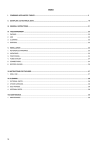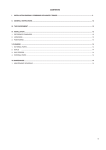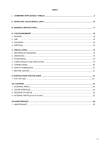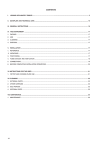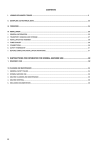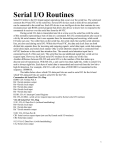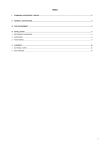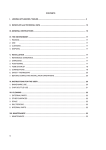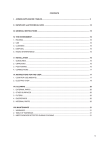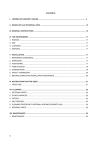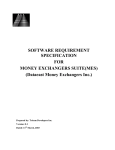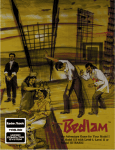Download User Manual
Transcript
INDEX I. COMBINING APPLIANCES / TABLES ....................................................................................................................................... 2 II. DATAPLATE and TECHNICAL DATA ......................................................................................................................................... 13 III. GENERAL INSTRUCTIONS ....................................................................................................................................................... 14 IV. THE ENVIRONMENT .................................................................................................................................................................. 15 1. PACKING .................................................................................................................................................................................... 15 2. USE .................................................................................................................................................................................... 15 3. CLEANING ................................................................................................................................................................................... 15 4. DISPOSAL ................................................................................................................................................................................... 15 V. INSTALLATION ........................................................................................................................................................................... 15 1. REFERENCE STANDARDS ........................................................................................................................................................ 15 2. UNPACKING ................................................................................................................................................................................ 15 3. POSITIONING .............................................................................................................................................................................. 15 4. CONNECTIONS ........................................................................................................................................................................... 16 5. SAFETY THERMOSTAT .............................................................................................................................................................. 16 6. BEFORE LEAVING ...................................................................................................................................................................... 16 VI. INSTRUCTIONS FOR THE USER .............................................................................................................................................. 17 1. BAIN MARIE USE ........................................................................................................................................................................ 17 2. CHIP SCUTTLE USE ................................................................................................................................................................... 18 VII. CLEANING ................................................................................................................................................................................... 18 1. EXTERNAL PARTS ...................................................................................................................................................................... 18 2. OTHER SURFACES .................................................................................................................................................................... 18 3. SCALE .................................................................................................................................................................................... 18 4. IDLE PERIODS ............................................................................................................................................................................ 19 5. INTERNAL PARTS ....................................................................................................................................................................... 19 VIII. MAINTENANCE .......................................................................................................................................................................... 19 1. MAINTENENCE SCHEDULE ...................................................................................................................................................... 19 12 II. DATAPLATE and TECHNICAL DATA IMPORTANT This manual contains information relevant to various appliances. See the appliance dataplate located under the control panel in order to identify the appliance (see fig. above). T A B L E A - E le c tric a p p lia n c e te c h n ic a l d a ta M O D EL S T EC H N IC A L D A T A + 7 BM EDB0 0 0 400 m m +7 BM EHB0 0 0 800 m m +7 BM EHB0 0 N 800 m m + 7 C S EDC 0 0 0 400 m m T a n k c a p a c ity (a t r e fe r e n c e le ve l) L. 5 10 10 - IS O 7 /1 c o n n e c tio n Ø - - - - kW - - - - - - - - V 220-230 380-400 230 230 P ha s e s No. 1N 3N 3 1N Fr e q u e n c y Hz 5 0 /6 0 5 0 /6 0 5 0 /6 0 5 0 /6 0 M a x . P ow e r kW 1 ,4 - 1 ,5 2 ,7 - 3 3 1 mm2 1 ,5 1 ,5 1 ,5 1 ,5 N o m in a l h e a t o u tp u t T yp e o f c o n s tr u c tio n P o w e r s u p p ly vo lta g e P o w e r c a b le s e c tio n 13 III. GENERAL INSTRUCTIONS • Carefully read the instruction handbook before using the appliance. • After installation keep the instruction handbook for future consultation. • FIRE HAZARD - Keep the area around the appliance clear and free from combustible materials. Do not keep flammable materials in the vicinity of the appliance. • Install the appliance in a well-ventilated place to avoid the creation of dangerous mixtures of unburnt gases in the room. • Air recirculation must take in account the air necessary for combustion, 2 m³/h/kW gas power, and also the “well-being” of those working in the kitchen. Inadequate ventilation causes asphyxia. Do not obstruct the ventilation system of the place where the appliance is installed. Do not obstruct the vents or ducts of this or other appliances. sos • Place emergency telephone numbers in a visible position. • Installation, maintenance and conversion to another type of gas must only be carried out by qualified personnel authorised by the manufacturer. For assistance, contact an authorised technical centre. Demand original spare parts. • This equipment is designed for cooking food. It is intended for industrial use. Any other use is to be considered improper. • This appliance is not intended for use by people (including children) with limited physical, sensory or mental abilities or without experience and knowledge of it, unless they are supervised or instructed in its use by a person responsible for their safety. • The appliance must be used by trained personnel. Do not leave the appliance unattended when operating. • Turn the appliance off in case of fault or poor operation. • Do not use products (even if diluted) containing chlorine (sodium hypochlorite, hydrochloric or muriatic acid, etc.) to clean the appliance or the floor under it. Do not use metal tools to clean steel parts (wire brushes or Scotch Brite type scouring pads). • Do not allow oil or grease to come into contact with plastic parts. • Do not allow dirt, fat, food or other residuals to form deposits on the appliance. • Do not clean the appliance with direct jets of water. • The symbol L given on the product indicates that it should not be considered domestic waste, but must be correctly disposed of in order to prevent any negative consequences for the environment and the health of persons. For further information regarding the recycling of this product, contact the product agent or local dealer, the after-sales service or the local body responsible for waste disposal. • • • • • Warnings: Do not store or use gasoline or other flammable vapours, liquids or items in the vicinity of this or any other appliance. Do not spray aerosols in the vicinity of this appliance while it is in operation. Never check for leaks with an open flame The appliance is not suitable for a marine environment. Failure to observe the above can compromise the safety of the appliance. Failure . to observe the above invalidates the warranty. 14 IV. THE ENVIRONMENT V. INSTALLATION 1.PACKING • Packing materials are environment friendly and can be stored without risk, or burned in a special waste incineration plant. Recyclable plastic components are marked with: PE Polyethylene: outer wrapping, instruction booklet bag, gas nozzle bag. Polypropylene: roof packing panels, straps. • Carefully read the installation and maintenance procedures given in this instruction manual before installing the appliance. • Installation, maintenance and conversion to another type of gas must only be carried out by qualified personnel authorised by the manufacturer. Failure to observe the correct appliance installation, conversion and modification procedures can cause damage to the appliance, danger to persons and invalidates the Manufacturer’s warranty. PP Polystyrene foam: corner protectors. PS 1. REFERENCE STANDARDS • Install the appliance in accordance with the safety regulations and local laws of the country where used. 2.USE Our appliances offer high performance and efficiency. To reduce consumption of electricity, water or gas, do not use the appliance empty or in conditions that compromise optimal efficiency (e.g. with doors or lids open, etc.); the appliance is used in a well-ventilated place to avoid the creation of dangerous mixtures of unburnt gases in the room. Whenever possible, pre-heat only before use. 3.CLEANING In order to reduce the emission of pollutants into the environment, clean the appliance (externally and when necessary internally) with products that are more than 90% biodegradable (for further information, see chap. V “CLEANING”). 4.DISPOSAL Do not disperse in the environment. Our appliances are manufactured using more than 90% (in weight) recyclable metals (stainless steel, iron, aluminium, galvanised sheet, copper, etc.). Make the appliance unusable by removing the power cable and any compartment or cavity closing mechanisms (when present) in order to avoid the risk of someone becoming closed inside. 2. UNPACKING IMPORTANT! Immediately check for any damage caused during transport. • The forwarder is responsible for the goods during transport and delivery. • Inspect the packing before and after unloading. • Make a complaint to the forwarder in case of visible or hidden damage, reporting any damage or shortages on the dispatch note on delivery. • The driver must sign the dispatch note. The forwarder can reject the claim if the dispatch note is not signed (the forwarder can provide the necessary form). • Unpack, taking care not to damage the equipment. Wear protective gloves. • Carefully remove the protective film from metal surfaces and clean any traces of glue with a suitable solvent. • For hidden damage or shortages becoming apparent only after unpacking, request the forwarder for inspection of the goods within and not later than 15 days of delivery. • Keep all the documentation contained in the packing. 3. POSITIONING • Handle the equipment with care in order to avoid damage or danger to persons. Use a pallet for handling and positioning. • The installation diagram provided in this instruction manual gives the appliance dimensions and the position of connections (gas, electricity, water). Check that they are available and ready for making all the necessary connections. • The appliance can be installed separately or combined with other appliances of the same range. • The appliances are not designed for built-in installation. Leave at least 10 cm between the appliance and side or rear walls. • Suitably insulate surfaces that are at distances less than those recommended. • Maintain an adequate distance between the appliance and any combustible walls. Do not store or use flammable materials and liquids near the appliance. • Leave an adequate space between the appliance and any side walls in order to enable subsequent servicing or maintenance operations. • Check and if necessary level the appliance after positioning. Incorrect levelling can cause appliance malfunctioning. 15 3.1. COMBINING APPLIANCES • (Fig.1A) Undo the 4 fixing screws and remove the control panels of the appliances. • (Fig.1B) Remove the fixing screw nearest the control panel, from each side to be joined. • (Fig.1D) Bring the appliances together and level them by turning the feet until the tops match. • (Fig.1C) Turn one of the two plates inside the appliances 180º. • (Fig.1E) From inside the control panel of the same appliance, join them at the front side, screwing one TE M5x40 screw (supplied) on the opposite insert. 4.2. EQUIPOTENTIAL NODE AND EARTH CONNECTION Connect the appliance to an earth; it must be included in an equipotential node by means of the screw located at the front right under the frame. The screw is marked with the symbol . 4.3. DISCHARGE Discharge water must be removed by means of a suitable receptacle resistant to a temperature of at least 100°C. The steam produced during the discharge phases must not involve the appliance. 3.2. FLOOR FIXING To avoid accidental tipping of built-in half-module appliances installed separately, fix them to the floor carefully following the instructions enclosed with the corresponding accessory (F206136). 3.3 INSTALLATION ON BRIDGE, CANTILEVER FRAME OR CEMENT PLINTH Carefully follow the instructions enclosed with the corresponding accessory. 3.4 SEALING GAPS BETWEEN APPLIANCES Follow the instructions supplied with the optional sealing paste pack. 4. CONNECTIONS • Any installation work or maintenance to the supply system (gas, electricity, water) must only be carried out by the utility company or an authorised installation technician. • See the appliance dataplate for the product code. • See the installation diagram for the type and position of appliance connections. 4.1. ELECTRIC APPLIANCES 4.1.1. ELECTRICAL CONNECTION (Fig. 4A - TableA). IMPORTANT! Before connecting, make sure the mains voltage and frequency match that given on the dataplate. • To access the terminal block, remove the appliance control panel by removing the fixing screws (fig. 4A 1-2). • Connect the power cable to the terminal block as shown in the wiring diagram attached to the appliance. • The power cable must pass through a protection pipe (when provided for) and secured with the special cable gland at the pipe entry. • Secure the power cable with the cable gland. IMPORTANT! The manufacturer declines any liability if the safety regulations are not respected. 4.1.2. POWER CABLE Unless otherwise specified, our appliances are not equipped with a power cable. The installer must use a flexible cable having characteristics at least equivalent to H05RN-F rubber-insulated type cables. Protect the cable section outside the appliance with a metal or rigid plastic pipe. 4.1.3. CIRCUIT BREAKER Install a circuit breaker ahead of the appliance. Contact opening distance and maximum leakage current must comply with current regulations. 16 5. SAFETY THERMOSTAT Some of our appliance models use a safety thermostat that cuts in automatically when temperatures exceed a set value, shutting off the gas supply (gas appliances) or the electricity (electric appliances). 5.1. RESET • Wait until the appliance has cooled down: a suitable temperature for resetting is approx. 90°C. • Press the red button on the safety thermostat body. IMPORTANT! If resetting requires the removal of a protective part (e.g. control panel) this must be done by a specialised technician. Tampering with the safety thermostat invalidates the warranty. 6. BEFORE LEAVING Check all connection for gas leaks with soap and water. Do not use a naked flame for detecting leaks. Ignite all burners both individually and combined to ensure correct operation of gas valves, burners and ignition. Turn gas taps to low flame for each burner, individually and separately, when satisfied with the appliance, please, instruct the user on the correct method of operation. In case the appliancefails to operate correctly after all checks have been carried out, refer to the authorised service provider in your area. VI. INSTRUCTIONS FOR THE USER 1.2. ELECTRIC MODELS B 1. BAIN MARIE USE 230 190 2 7 0 210 0 25 1 7 0 110 C 0 15 0 90 C 1 7 0 60 30 A E Switching on (mod. 800mm) • Turn on the main switch located ahead of the appliance. • turn the knob of switch “B” to position “I” • Turn thermostat knob “A” to the required temperature. • Lighting up of green indicator “C” indicates that the machine is on. C 230 27 0 0 25 190 210 17 0 D 0 15 General precautions • Carefully read this instructions manual, insofar that it contains important information concerning the safety, operation and maintenance of this appliance. • Keep this instructions manual in a safe place for future consultation by other users. • Installation of this appliance and its conversion to a different gas supply, must only be performed by a qualified installer. • Only contact the technical service centre authorized by the manufacturer for repairs and only use original spare parts. Failure to comply with the above instructions may jeopardise the safety of this appliance. • Our appliances have been designed and optimised by means of laboratory tests to guarantee high levels of performance and efficiency. However, to save energy (electricity, gas and water) avoid using the appliance under no-load conditions or conditions that impair optimal operation (e.g. with the doors/lids open). Also, when possible, pre-heat the appliance before use. • This appliance must be used only for the purpose for which it was intended, i.e. for indirect cooking in containers and for keeping food warm in bain-marie. Any other application is understood to be improper. 1.1. WATER FILLING • Fill the tank with water up to the reference level. • Introduce water in the tank using a manual system. Important! Never us the bain-marie without water in the tank (dry). Switching on (mod. 400mm) • Turn on the main switch located ahead of the appliance. • Turn the only knob “A”, which makes the commutator and thermostat simultaneously intervene on the required temperature. • Lighting up of green indicator “C” signals that the power is on. • Introduce water in the tank using the manual system. Switching off Turn the control knobs to “0”. 1.3. WATER DISCHARGE • Place a bowl for collecting water at the drain pipe. • Press and turn the cock knob anticlockwise to discharge the water from the tank. 17 2. CHIPS SCUTTLE USE VII. CLEANING IMPORTANT! Before carrying out any cleaning operation, disconnect the appliance from the power supply. B A 0 1 0 General precautions • The appliance is intended for industrial use by trained personnel. • This appliance must only be used for its expressly designed purpose; i.e. for keeping fried food hot. Any other use is to be considered improper. Switching on • Turn on the main switch located ahead of the appliance. • Turn the knob of switch “A” to position “1”. Lighting up of indicator “B” signals that the appliance is on and heating is by an infrared lamp (heating element). Switching off • Turn control knob “A” to off position “0”. • Turn off the electrical switch installed ahead of the appliance. 1. EXTERNAL PARTS SATIN-FINISH STEEL SURFACES (daily) • Clean all steel surfaces: dirt can be easily removed as soon as it forms. • Remove grime, fat and other cooking residuals from steel surfaces when cool using soapy water, with or without detergent, and a cloth or sponge. Dry the surfaces thoroughly after cleaning. • In case of encrusted grime, fat or food residuals go over with a cloth or sponge, wiping with the grain of the satin finish, and rinsing often: rubbing in a circular motion combined with the particles of dirt on the cloth/sponge could ruin the steel’s satin finish. • Metal objects can ruin or damage the steel: ruined surfaces become dirty more easily and are more subject to corrosion. • Restore the satin finish if necessary. SURFACES BLACKENED BY HEAT (when necessary) Exposure to high temperatures can cause the formation of dark marks. These do not constitute damage and can be removed by following the instructions given in the previous paragraph. 2. OTHER SURFACES HEATED TANKS/CONTAINERS (daily) Clean the appliance tanks or containers using boiled water, adding soda (degreasing) if necessary. Use the accessories (optional or supplied) specified in the list to remove encrustations or food deposits. IMPORTANT – With electric appliances, make sure no water comes into contact with electrical components: water penetration can cause short circuiting and dissipation, tripping the appliance’s protection devices. 3. SCALE STEEL SURFACES (when necessary) Remove any scale (stains or marks) left by hard water on steel surfaces using suitable natural (e.g. vinegar) or chemical (e.g. “STRIPAWAY” produced by ECOLAB) detergents. BOILERS OR CAVITIES (at least monthly) • Descale the devices used for collecting and heating water (e.g. cavities of indirect pots) by filling them with pure vinegar or a chemical detergent (1/3) and water (2/3). VINEGAR • Heat for about 5 minutes • Allow the vinegar to work for at least 20 minutes. • Rinse with plenty of water. CHEMICAL DETERGENT • Heat for about 3 minutes • Allow the solution to work for at least 10 minutes. • Rinse with plenty of water. 18 4. IDLE PERIODS If the equipment is not going to be used for some time, take the following precautions: • Close cocks or main switches ahead of the appliance. • Go over all stainless-steel surfaces vigorously with a cloth moistened with paraffin oil in order to spread a protective film. • Periodically air the room. • Have the appliance checked before using it again. • To prevent too rapid evaporation of accumulated moisture with consequent breakage of elements, switch electric appliances on at minimum heat for at least 45 minutes before reuse. 5. INTERNAL PARTS (every 6 months) IMPORTANT! Operations to be carried out only by specialised technicians. • Check the condition of internal components. • Remove any built-up grime inside the appliance. • Check and clean the discharge system. NB ! In particular ambient conditions (e.g. intensive use of the appliance, salty environment, etc.) the above cleaning should be more frequent. VIII. MAINTENANCE 1. MAINTENENCE SCHEDULE • It is reccommended the appliance is inspected and serviced by an authorized person at least every 12 months. For this purpose it is reccommended to draw up a maintenece contract. 19









